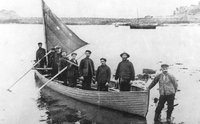A particularly violent storm in December 1907 brought with it the death of 17 men aboard the largest sailing ship of her day. Only two of the eighteen crew members were ever rescued and a Local Pilot was drowned aboard the ship.
- Job: Bulk Oil Carrier
- Tonnage: 5218 tonnes
Incident
- Difficulty: Ran aground, wrecked
- Date: 13 December 1907
- Shipping route: Philadelphia to London
- Passengers & cargo: 60,000 barrels of oil
- Location: Western Rocks
The boat was named the Thomas W. Lawson, she was built in Boston for the transpacific trade links but was later converted to carry oil in bulk across the Atlantic. She was the only seven mast schooner ever built, her masts named Sunday, Monday, Tuesday, Wednesday, Thursday, Friday and Saturday; there had been nothing similar before and there has been nothing similar since. She was of gargantuan proportions of her day, she weighed in an a staggering 5218 tonnes and was valued at $400,000. Because of her unique enormity, she was sluggish and difficult to manoeuvre, especially when carrying her 60,000 barrels of oil. This was the case, when on the 13 December she sailed straight amongst the Western Rocks just west of St Agnes when she mistook the Bishop Rock Lighthouse for a passing schooner.
Her lifeboats had been rendered useless in the terrible seas she encountered crossing the Atlantic, so the only course of action to take was to lay anchor in Broad Sound and ride out the storm as her size and the conditions prohibited any manoeuvre to get clear of the Islands. She sent out no distress signals.
The St Agnes Pilots launched their lifeboat as did St Mary’s; the St Agnes boat left Perigless in a storm of ever increasing ferocity at about 4:00 pm and reached the vessel at about 5:00 pm. They found the Lawson anchored dangerously close to Gunners Rock. The lifeboat men were putting themselves at great risk in gigantic seas, and recommended that Lawson be moved and the crew of the Lawson be evacuated.
Captain Dow of the Lawson refused to move nor leave his boat and there was nothing the St Agnes crew could do for the boat. Eventually it was agreed that a Local Pilot would be put aboard, William Cook Hicks, and a signal was agreed; if the boat got further into trouble, a flare would be lit on deck.
By this time, the St Mary’s boat had returned home after sustaining damage to her mast when it got trapped under the Lawson’s quarter. She was instructed to return to St Mary’s for repairs and also organise a tug from Falmouth to come over to the Islands.
The St Agnes boat then returned home with a sick crew member. A watch was kept from St Agnes Lighthouse to look for many signs of the signalled. At 0115 the port anchor failed and she started drifting slowly with only the starboard anchor to hold her. At this point the storm was still raging and at about 3:00 am, the lookout reported that a terrible squall had hit and the light on the Lawson has gone out. It was presumed that the reason for this was the the terrible weather had put out oil lamps aboard. No flare was ever seen. Within the hour, the stench of oil had engulfed the islands in a blanket that signalled disaster for the lifeboat crews. The ensuing tragedy was anticipated by the St Agnes crew, whom gathered at Perigless before dawn, ready to launch the gig Slippen.
Frederick Hicks, son of the pilot on board, assisted the lifeboat with the search for the Captain and his father. They found the Captain and Engineer Rowe, clinging to Helwether Rocks. Frederick Hicks swam to reach them with a rope with which they were able to be rescued. The Captain explained that once the ship was doomed, the Captain, Engineer, Pilot and crew lashed themselves to the rigging. The ship broke in two between her sixth and seventh masts. When the masts fell the Captain and Engineer were washed off the deck, while the Pilot remained entangled in the rigging.
##References
- “The Severe Gale”. (17 December 1907). The Times, p. 10.
- “Schooner Lawson Wrecked; 15 Drown”. (15 December 1907). The New York Times, p. 10.
- “A Lawson Survivor Dies”. (16 December 1907). The New York Times, p. 10.


